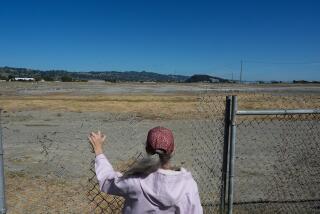Villagers Learning a Frightening Secret : Ecology: U.S. reveals that it buried radioactive soil near Alaska town 30 years ago. Residents fear that the atomic testing may have damaged the food chain.
ANCHORAGE, Alaska — Residents of the northwest Alaska village of Point Hope know what it takes to eke a livelihood out of the harsh Arctic.
Many of their skills focus on staying fed--chasing bowhead whales and walruses, hunting migrating caribou herds, picking murre eggs off cliffs high above the roiling Chukchi Sea.
Now, there’s a premium on knowledge of nuclear radiation: In September, the government revealed that it buried 15,000 tons of soil contaminated with radioactive isotopes at Cape Thompson, 25 miles away, as part of a research project in 1962.
The 450 residents of Point Hope and those in nearby communities regularly hunted and gathered and traveled through the area and are angry about the nuclear waste.
“Most of the individuals are still upset,” said Point Hope Mayor David Stone. “They want to get back and get even somehow.”
There is an above-average cancer rate in Point Hope, but officials have attributed it to smoking and diet. Villagers now fear that it may be related to Project Chariot and above-ground atomic testing that may have damaged the food chain.
Earlier this month, officials of the U.S. Department of Energy, the state Department of Environmental Conservation and some nuclear specialists conducted educational workshops in Barrow, Point Hope, Kivalina and Kotzebue.
Topics included basic explanations of radiation, its health effects and the history of the project.
The project was declassified in 1981 but it wasn’t until this year that University of Alaska-Fairbanks researcher Dan O’Neill publicized documents that he inadvertently found through a Freedom of Information Act request.
In 1962, Eskimos successfully fought a federal government plan to use a nuclear blast to create a harbor out of ice at Cape Thompson. But that year, the U.S. Geological Survey went ahead with a secret plan to bury the radioactive soil, which included more than 43 pounds of nuclear material from a test blast in Nevada.
First, the tainted soil was placed in a dozen pits as a way to determine how radioactivity spreads in an arctic environment, then it was buried in a four-foot-deep, unmarked mound of clean dirt.
Investigators in September detected no radiation on the surface, but low levels were recorded after they drilled about two feet into the mound.
Gov. Walter J. Hickel and Sen. Frank Murkowski (R-Alaska) visited the site and demanded it be cleaned up.
The Energy Department said it pushed its cleanup schedule back from March to July after villagers expressed concern that the effort would interfere with their spring whaling season.
While government officials are coming north to talk, villagers are skeptical about anything they have to say.
“I don’t think they’re telling the truth at all,” Stone said. “If they can keep something hidden for 30 years, why should they tell us the truth now?”
The North Slope Borough, which governs eight villages in the area, has hired its own environmental consultant to find records and review documents and other information coming from other independent sources.
“We’ve been sending up some educational material and giving people the names of experts and trying to provide some understanding of the issues when you’re talking about cancers,” said Carl Hild, director of the nonprofit Alaska Health Project, based in Anchorage, 750 miles southeast of Point Hope.
“But one of my frustrations is that we might not be asking the right questions,” Hild said. “There are a lot of documents from Project Chariot that aren’t yet declassified, and a lot of things that still haven’t been said.”
Energy Department spokesman Tom Gerusky acknowledged that the Geological Survey erred in burying the waste but said a person standing on the mound for a year would be exposed to only a small fraction of radiation received in a single cross-country jet flight.
Residents need persuading.
“I’m not going to buy into anything until we get all of the reports and all of the sampling and all of the people checked out,” said Ray Koonuk Jr., a leader in the fight for information. “We still have a long way to go to resolve this problem.”
More to Read
Sign up for Essential California
The most important California stories and recommendations in your inbox every morning.
You may occasionally receive promotional content from the Los Angeles Times.










